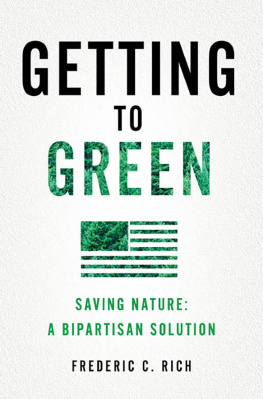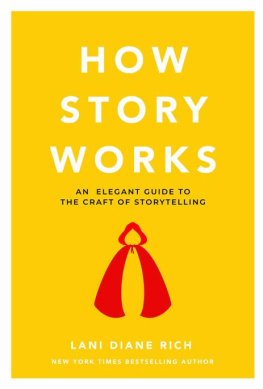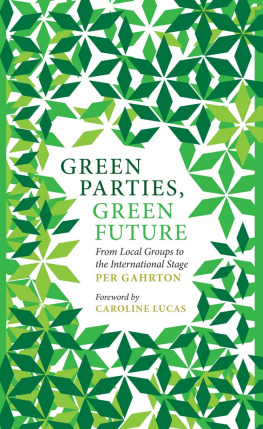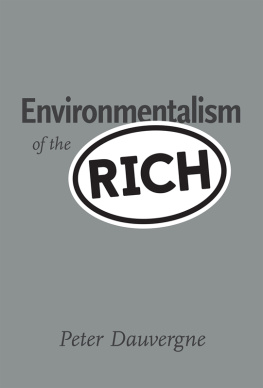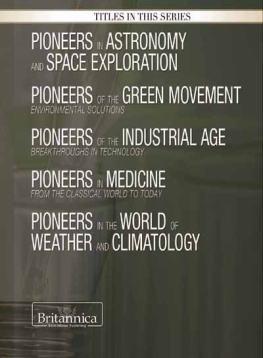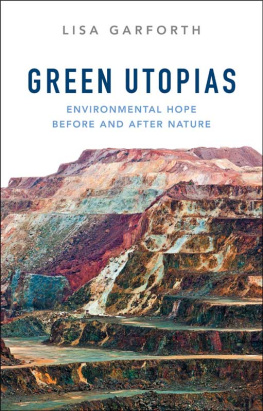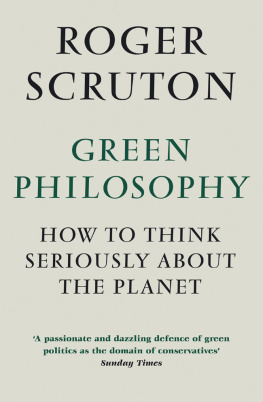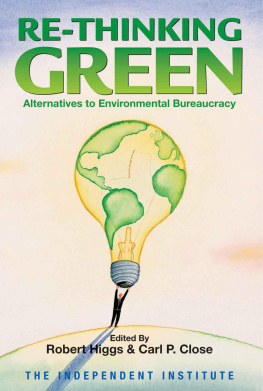
Praise for Getting to Green
This country is ripe for a new era of pragmatic problemsolving. Richs prescription for ending partisan gridlock on the environment is sensible, based on our shared values as Americans. Tightly argued and persuasive, Getting to Green is mandatory reading for anyone who cares about climate change, or about fixing the dysfunction in government.
U.S. SENATOR EVAN BAYH
My fellow environmental leaders may not agree with every word, but we ignore this book at our peril. It never occurred to Teddy Roosevelt that Republicans should oppose conservation, and Getting to Green persuasively argues that conservatives still should support the responsible stewardship of nature. With a career at the highest levels of global capitalism and as a greatly respected environmental leader, Fred Rich is in a unique position to bring the right and left together to find practical solutions to our environmental challenges.
RAND WENTWORTH, PRESIDENT, LAND TRUST ALLIANCE
Rich rethinks the foundations and rewrites the playbook of the American Green movement. In an exploration that is by turns history lesson, political commentary, philosophical analysis, and campaign strategy session, he succeeds in showing that one of the most angrily contested topics in contemporary politics could be, if we can reset some of the basic rules of communication, a place of deep and meaningful consensus. Richs stimulating book is both a challenging and a well-informed examination of a very important contemporary issue and an insightful starting point, one might hope, for a broad reconsideration of many other issues that now divide us.
GREGORY E. KAEBNICK, THE HASTINGS CENTER, AUTHOR OF HUMANS IN NATURE
As someone who believes in putting governance ahead of politics, I welcome this call to transcend the partisanship that has stood in the way of urgently needed action on climate change and the environment. Regardless of your place on the political spectrum, there is much to admire in this book, which reminds us that the stewardship of nature is an obligation shared by all Americans.
U.S. SENATOR ANGUS S. KING JR.
Dare conservatives ask, Can free enterprise solve climate change? and dare progressives imagine something more efficient than a regulatory solution? If, as Fred Rich suggests, we come together around shared values like love, wisdom, and compassion, then taking action on climate change, now seemingly impossible, will become inevitable without ever passing through the probable. Getting to Green shows the way: Conservatives need to be welcomed as the indispensable partners for action on climate and other environmental issues.
BOB INGLIS, SIX-TERM GOP CONGRESSMAN FROM SOUTH
CAROLINA, DEFEATED FOR CHANGING HIS VIEW ON
CLIMATE CHANGE; WINNER OF THE 2015 JOHN F.
KENNEDY PROFILE IN COURAGE AWARD
The environmental and conservation communities must learn to work together, as they once did, if we are to successfully safeguard our natural resources for the future. Getting to Green presents a thoughtful analysis of where the Green movement is today, and a compelling case for what Greens must do to regain broad public support. Whether you are an environmentalist or a conservationist, liberal or conservative, you must read this book.
SIMON ROOSEVELT, FOUNDER, CONSERVATION
ROUNDTABLE, AND AUTHOR OF AMERICAN
HUNTING AND CONSERVATION (FORTHCOMING)
Copyright 2016 by Frederic C. Rich
All rights reserved
First Edition
For information about permission to reproduce selections from this book,
write to Permissions, W. W. Norton1 & Company, Inc.,
500 Fifth Avenue, New York, NY 10110
For information about special discounts for bulk purchases, please contact
W. W. Norton Special Sales at specialsales@wwnorton.com or 800-233-4830
Book design by Chris Welch Design
Production manager: Julia Druskin
ISBN 978-0-393-29247-3
ISBN 978-0-393-29248-0 (e-book)
W. W. Norton & Company, Inc.
500 Fifth Avenue, New York, N.Y. 10110
www.wwnorton.com
W. W. Norton & Company Ltd.
Castle House, 75/76 Wells Street, London W1T 3QT
This book is dedicated to the late Frances Stevens Reese.
Contents
2 IT WASNT ALWAYS THIS WAY
A Brief History of Conservation and the Right
3 WHAT WENT WRONG
The Great Estrangement
4 THE ULTIMATE WEDGE ISSUE
Climate Change
5 MARKET FUNDAMENTALISM
The Antienvironmental Orthodoxy of the Right
6 UNEASY ABOUT GROWTH
The Anticapitalist Tendency in Environmentalism
8 GETTING TO GREEN, STEP ONE
Reconnecting Conservatives with Conservation
10 GETTING TO GREEN, STEP TWO
A Philosophy That Puts People First
11 GETTING TO GREEN, STEP THREE
Reforming the Green Movement
12 A MODEL FOR CENTER GREEN
The Land Trust Movement in America
15 CENTER GREEN ON THE HEADLINE ISSUES
Hydro-fracturing and Keystone
16 GETTING TO GREEN
What You Can Do
GETTING TO
GREEN
O n November 15, 1990,
This was a piece of legislation that actually achieved the reversal of large-scale environmental damage, used a market mechanism dear to conservatives, and avoided the economic sacrifices feared by business while providing net economic benefits to the nation. In a statement following the signing ceremony, Bill Reilly said the legislation would undoubtedly serve as a model... leading to the widespread use of market approaches here and abroad. It seemed that Washington had found a way to satisfy both environmentalists and conservatives, and the Green movement could deploy this template to address a range of other pressing issues. The future looked bright.
Instead, November 15, 1990, marks the day that the Green movement hit a legislative dead end. No president in the quarter century since then has signed a major environmental bill. Every subsequent attempt by the Green movement to forge a national legislative solution to national environmental problems, including global warming, ended in failure.
And what Green issue has Washington, D.C., in its grip today? Climate change and sea level rise? Ocean acidification, perhaps? Water supply and water quality? Species extinction and biodiversity? No. The environmental cause clbre in America in the early twenty-first century was Keystone XL, the proposal by a Canadian pipeline company to add 875 miles of additional pipeline to the countrys existing network of over 190,000 miles of crude and liquid petroleum product pipes and 305,000 miles of inter- and intrastate natural gas transmission pipe. The environmental movement enthroned opposition to Keystone as a litmus test of Green orthodoxy, despite the fact that the pipeline itself does not present any unusual environmental risks, its approval or nonapproval would not affect the development by our Canadian neighbors of their dirty tar sands (which is a fait accompli), and the impact on carbon emissions would be, according to the New York Times, infinitesimal.
In 1990 the Green movement fought a battle where the prize was a 50 percent reduction in damaging acid rain; in 2015, the Green movement's prize, President Obama's denial of the Keystone permit, was almost wholly symbolic, a tactical victory without any meaningful impact on the natural world. And the costs of this six-year campaign by Greens? We created a potent issue that energized the anti-Green right, caused significant political complications for a friendly president, and, most importantly, distracted the public and committed Greens from making real progress on far more pressing environmental issues.
How did this happen?
Environmentalism, one of the most successful mass movements of the modern era, has transformed America. In only five decades it has reversed polluting practices that prevailed since the dawn of the Industrial Revolution, improved air quality, restored many waterways to a cleanliness not seen since the early nineteenth century, protected vast tracts of wilderness, and attracted millions of adherents. It is a breathtaking record of achievement.
Next page
